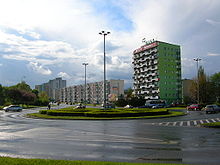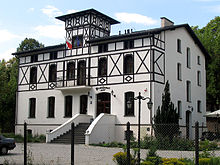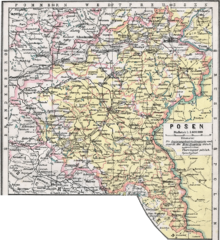Piła
![]()
The title of this article is ambiguous. For other meanings, see Piła (disambiguation).
![]()
Schneidemühl is a redirect to this article. For the German veterinarian and university lecturer see Georg Schneidemühl.
Piła [ˈpi.wa] (German Schneidemühl) is a city in the Polish voivodeship of Wielkopolska. With its numerous industrial plants and large-scale enterprises in the specialist fields of chemistry, metal and wood processing, agriculture, as well as being a railway junction and the seat of a large railway repair plant, the city is of supra-regional importance.
During the Weimar Republic, Schneidemühl, as the capital of the new province of Grenzmark Posen-Westpreußen, had taken over important administrative functions in place of the large cities of Posen and Bromberg, which had fallen to Poland in 1920. During this period numerous representative public buildings in architecturally demanding contemporary architectural style were built in the until then rather unimportant town. Despite subsequent severe destruction during the Second World War, some high-quality architectural examples of German early modernism of the 1920s have survived to the present day.
Location
The town lies in the border area between the former regions of West Prussia and Poznan, about 60 kilometres south of Szczecinek (Neustettin), 30 kilometres south of the historical border of Hinterpommern and 50 kilometres east of the former Neumark, in wooded surroundings, barely ten kilometres north of the Noteć - Netze, on both sides of the river Gwda (Küddow). The older and larger part of the town area is located on the right (western) side of the river. Other, smaller watercourses run through the narrow city area, such as the Mühlenfließ in the north or the Färberfließ in the south of the old town.
History
The village was probably founded in 1380 and was mentioned as a town in a document of 1451. On March 4, 1513, the Polish King Sigismund I granted it the town charter of Magdeburg.
In 1626, Schneidemühl was so badly destroyed by a large fire that had begun to blaze near the old Catholic church and spread rapidly that the landlady of the town, Queen Constanze of Austria, instructed her secretary Samuel Tarjowski to carry out a new survey of the town. The reconstruction plan called for the city core to be moved from the Old Market to the New Market, which was now to be rebuilt. The New Market had an almost square shape, and five streets started from it. The town hall was to be built in its centre. This redesign still largely characterizes the cityscape today. On the occasion of this reconstruction, the Jews, whose residences had previously been scattered throughout the city, were assigned a separate residential district, a Judenviertel.
After the Great Plague of 1709/10, only seven people lived in Schneidemühl. With the First Partition of Poland (1772) the town passed from Poland to the Kingdom of Prussia. Another big fire destroyed half of the town in 1781.
As late as 1774, Poles made up almost half of the population (620 out of 1322); however, by 1900, the Polish population had dropped below five percent.
19th and early 20th century
With the establishment of the Duchy of Warsaw in 1807 Schneidemühl came temporarily back under Polish rule. The town hill remained Prussian. As a result of the border demarcation of 1807, after the Congress of Vienna the border areas of Greater Poland located north of the town did not belong to the Prussian province of Posen, but to the province of West Prussia, or Province of Prussia from 1829 to 1878.
After the Congress of Vienna Schneidemühl belonged in the Prussian province Posen to the administrative district Bromberg and to the district Kolmar i. Posen.
The town experienced a significant boom with the opening of the Prussian Eastern Railway in 1851. Here the main line, initially coming from Lukatz (only from 1866 from Berlin), branched off into the first (July 1851) completed branch to Bromberg (Bydgoszcz), which was later extended via Thorn (Toruń) to East Prussia, and the main line via Dirschau (near Danzig) to Königsberg, which was opened a year later (August 1852). Due to its central location in the northeast German rail network, the railway junction Schneidemühl became the site of a repair shop of the Ostbahn and later of the Deutsche Reichsbahn.
As a result of the good railway connections, numerous industrial companies also settled here. The town was in constant economic growth. At the beginning of the 20th century Schneidemühl had three Protestant churches, a Catholic church, a church of the Protestant Community, a synagogue, a grammar school, a secondary school, a school teachers' seminary, a district court and a number of factories and production plants. From 1913 to 1914, one of the largest aircraft factories in the German Empire at the time was built. The Ostdeutsche Albatros Werke (OAW) was a subsidiary of the Albatros Flugzeugwerke in Johannisthal near Berlin.
When the number of inhabitants had risen to 25,000 in 1914, Schneidemühl left the district of Kolmar in Posen and formed its own city district as of April 1, 1914.
On September 11, 1918, a tragic railway accident occurred near Schneidemühl. A freight train and a special train carrying children collided. 35 people died, 18 others were injured.
New provincial capital
After the cession of most of the province of Posen and West Prussia to Poland under the Versailles Peace Treaty, the Bydgoszcz government moved its seat to Schneidemühl in 1919. On November 20, 1919, it began its work as the government office for the administrative district of Grenzmark Westpreussen-Posen. It administered all areas of the provinces of Posen and West Prussia west of the Vistula that remained with the German Reich. From 11 January 1921, the government office in Schneidemühl bore the name Posen-Westpreußen. Since 1 July 1922 Schneidemühl was the capital of the new province Grenzmark Posen-Westpreußen. At the same time the railway station of Schneidemühl became border station in the traffic to Poland and in the transit traffic to East Prussia.
The new provincial capital was developed at great expense. Schneidemühl had hitherto been a small town and was now to form the centre for all the areas that remained German between Pomerania, Brandenburg and Silesia on the one hand and East Prussia on the other. The new Reich border ran only a few kilometres east of the town, through which the traffic between East Prussia, which had become a German exclave, and the rest of Germany rolled.
The focus of construction activity was the new Danziger Platz, previously the site of a horse market and a racecourse. Here, between the main railway station, the city centre and the Küddow, a forum was created, a rectangular square, with the government building (1925-1929) flanked by the Behördenhaus (tax and customs office, today the city hall) and the "Reichsdankhaus" (Paul Bonatz, 1927-1929) on the right, consisting of the Landestheater and the Landesmuseum.
The structures created had been planned in anticipation of further growth in the rapidly industrializing city. The Landestheater, located in the Reichsdankhaus, had a large auditorium with a capacity of 1,200 and its own symphony orchestra.
The background to these expensive measures was the political will to slow the exodus from the eastern provinces, which had been severely weakened economically by the establishment of the Polish Corridor, and to create a new attractive German cultural centre in the east after the loss of important cultural centres such as Danzig and Posen, Bromberg and Thorn to Poland. The then Second Polish Republic aimed to reverse in the reclaimed territories the Germanization that had taken place since the first partition of Poland in 1772.
In 1934, the Polish government unilaterally terminated the Treaty for the Protection of Minorities between the Allied and Associated Powers and Poland, concluded in Versailles on 28 June 1919. The result was a large influx of displaced persons and refugees from the area of the Polish Corridor as well as from other areas now under Polish sovereignty or occupied by Poland. The population increased to over 43,000. Temporary camps were set up in rooms of the Albatros works and in other buildings in the city. Of the approximately 168,000 refugees routed through Schneidemühl, about 50,000 passed through the refugee camps in Schneidemühl. The influx was particularly large when the so-called optanten expulsions from Poland took place in 1925. On the German side one spoke of the "burning border in the East"; the term referred both to the pain of separation and revanchist desires concerning the lost territories on one's own side and to the numerous violations of the Treaty of Versailles on the Polish side, most of which were tolerated by the Allied World War II victors. The development of Schneidemühl into an administrative, cultural and economic centre of the border region was intended to stabilise conditions there.
Schools, churches and other public buildings were also built elsewhere in the town during this period. Schneidemühl experienced rapid growth during the interwar period. Before the beginning of the First World War it had 26,000 inhabitants, before the beginning of the Second over 45,000.
By 1930, the town of Schneidemühl had an area of 72.2 km² and 34 residential villages, with a combined total of 1,817 residential buildings. The places of residence were:
- Albertsruh
- Old clubhouse
- Station Königsblick
- Bergenhorst
- Oak Hill
- Oak Cat Pitcher
- Friedrichstein railway stop
- Elisenau
- Refugee home
- Forester's Lodge Dreisee
- Green valley forester's lodge
- Forester's lodge Kleine Heide
- Königsblick forester's lodge
- Fridasthal
- Glubczyner Way
- Heather Pitcher
- Karlsberg
- Kiebitzbruch
- Kossenwerder
- King's View
- Lehnsruh
- Margaret Court
- New Cameroon
- Newfie
- Plöttke
- Restaurant Königsblick
- Restaurant Schweizerhaus
- Schneidemühl
- City Goat House
- Green valley forest works
- Fulling Mill
- Willow Quarry
- Weidmannsruh
- Wiesenthal
In 1925, the population of the town of Schneidemühl was 37,520, distributed among 9,261 households.
National Socialist Government and the Second World War
The province of Grenzmark Posen-Westpreußen, of which Schneidemühl had become the capital, had already been co-administered by the Chief President of the Province of Brandenburg in personal union since 1933, but was then abolished on October 1, 1938 and (with changed boundaries) incorporated as a governmental district of the Province of Pomerania. Schneidemühl remained the administrative center as the capital of the administrative district of the same name. The Länder and their provincial administrations, however, had lost most of their importance since the Gleichschaltung in 1933; real power lay instead with the Gauleiter in the Gau Pommern. In 1936, a college for teacher training was established under the director Gerhard Bergmann, which continued as a teacher training college from 1941.
The invasion of Poland in 1939 did not have a considerable impact on Schneidemühl, as the fighting immediately shifted to areas outside the Reich's borders. The Russian campaign in 1941, on the other hand, soon left Schneidemühl's factories short of manpower as more and more men were drafted.
In 1940, about 160 Jews from Schneidemühl were deported to the East by the Nazi regime; the deportees were originally supposed to be housed in the Nisko ghetto according to the Nisko Plan, but ended up in ghettos nearby. The town's Jewish community, which made up 20% of the population in the mid-19th century and numbered 625 by the end of the 1920s, ceased to exist towards the end of the war. Today there is no Jewish life in the city.
In 1944, 6,000 people from the Westphalian industrial area were evacuated to Schneidemühl. The Fourth Community School took in an elementary school from Lünen, the commercial school an elementary school from Castrop-Rauxel. A secondary school from Bochum received classes in the Freiherr-vom-Stein-Gymnasium. In 1944 there was an air raid on Schneidemühl, which was presumably aimed at the aircraft factories, but did not cause much damage. Since August 11, 1944 the population of Schneidemühl was used to build defensive fortifications in the woods at the southern and eastern outskirts of the town near Albertsruh, Königsblick and Küddowtal. Parts of the Organisation Todt and thousands of construction workers from Pomerania were used to build anti-tank trenches. The Reichsschülerheim was set up as a military hospital for the Organisation Todt. The fortress construction staff lodged in the Fourth Municipal School. After Schneidemühl was declared a fortress, emergency wells were drilled to supply drinking water and food was stockpiled sufficient for 25,000 to 30,000 people for about a quarter of a year. The reserve hospital was expanded to 3,000 beds.
On January 24, the neighboring villages of Königsblick and Plöttke were under fire from the Red Army. The civilian population in Schneidemühl had not received an evacuation order by then, and people now tried to leave the town on foot, with horse-drawn carriages, on trucks, and in overcrowded trains. Only hand luggage was allowed on the trains, but for lack of space even this often had to be left behind. On 26 January 1945, Soviet troops took the city centre and the railway station under fire from the Usch heights with Stalin organs and artillery. After the last train had left Schneidemühl on 26 January, the battle for the town broke out soon after the railway line was interrupted. On January 31, the Soviet troops succeeded in encircling Schneidemühl. Until February 10 a Ju 52 could still land every evening on the airfield of the former Albatroswerke on Krojanker Straße and fly out wounded and civilians. Then this connection to the outside world also failed. The commander Heinrich Remlinger (1913-1951) had about 22,000 men at his disposal to defend the city, some of whom, however, were only poorly trained and lacked heavy weapons, including units of the Volkssturm. After heavy fighting, the German troops, numbering about 15,000, retreated across the Küddow to try to break out of the encirclement. After they had crossed, the bridges of the Küddow were blown up. Only 350 wounded could be taken in municipal omnibuses. Several thousand wounded had to remain behind. For their care 25 medics and six doctors voluntarily stayed behind. The attempt to break out failed, and with the dawn of February 14 the final battle for the city began. Three of the doctors who voluntarily stayed behind were killed when the Red Army captured the city.
During the fighting around the Pommernwall at the end of the Second World War, 75% of the city was destroyed, in the centre about 90% of all buildings.
After the end of the war, Schneidemühl was placed under Polish administration by the Soviet occupying power in the summer of 1945 in accordance with the Potsdam Agreement and was given the Polish place name Piła. Subsequently, most of the German inhabitants were expelled by the local Polish administrative authorities.
Present
The city, which was largely destroyed, was rebuilt in a modern way, with a road network that has changed considerably in places. From 1975 to 1998 Piła was the capital of Piła Voivodeship, since then it has belonged to the Wielkopolska Voivodeship, governed from Poznań. In 1999, the city became the seat of the Pilski powiat. Today, the city with its many industries (chemical, metal and wood processing, agriculture) is of supra-regional importance as a railway junction and as the seat of a large railway repair plant.
Today there are still about 800 Germans living in Piła, who have joined together to form a circle of friends (German Social-Cultural Society in Schneidemühl). The expellees and some of their descendants are organized in the Heimatkreis Schneidemühl e. V., based in Cuxhaven, and in this way remain connected to their original living environment.

Cityscape with architecture from the 20th century

River Gwda (Küddow) in the city centre

Historical building

Former officers' mess

Prussian barracks of the Fliegerersatzabteilung 2 in Schneidemühl 1915

Schneidemühl north of the city of Posen and west of the city of Bromberg on a map of the province of Posen from 1905 (areas marked in yellow indicate areas with a majority Polish-speaking population at that time)
Search within the encyclopedia